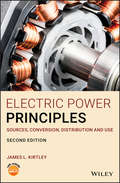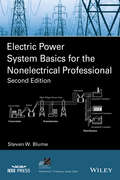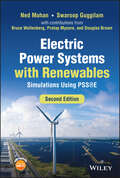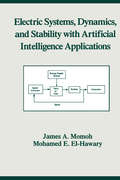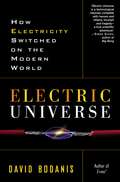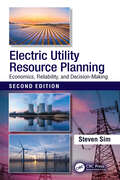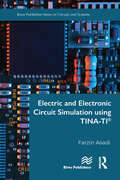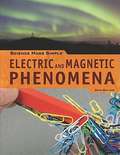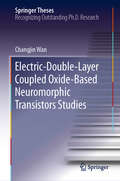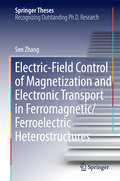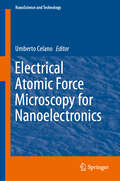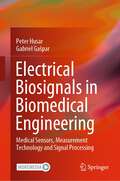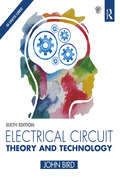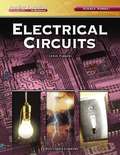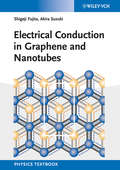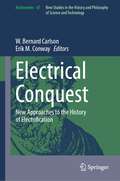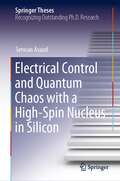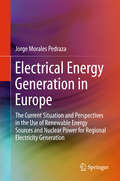- Table View
- List View
Electric Power Distribution, Automation, Protection, and Control
by James A. Momoh<p>New methods for automation and intelligent systems applications, new trends in telecommunications, and a recent focus on renewable energy are reshaping the educational landscape of today's power engineer. Providing a modern and practical vehicle to help students navigate this dynamic terrain, Electric Power Distribution, Automation, Protection, and Control infuses new directions in computation, automation, and control into classical topics in electric power distribution. <p>Ideal for a one-semester course for senior undergraduates or first-year graduate students, this text works systematically through basic distribution principles, renewable energy sources, computational tools and techniques, reliability, maintenance, distribution automation, and telecommunications. Numerous examples, problems, and case studies offer practical insight into the concepts and help build a working knowledge of protection schemes, fault analysis and synthesis, reliability analysis, intelligent automation systems, distribution management systems, and distribution system communications. The author details different renewable energy sources and teaches students how to evaluate them in terms of size, cost, and performance. <p>Guided firmly by the author's wealth of industrial and academic experience, your students will learn the tools and techniques used to design, build, and operate future generations of distribution systems with unparalleled efficiency, robustness, and sustainability.</p>
Electric Power Principles: Sources, Conversion, Distribution and Use
by James L. KirtleyA revised and updated text that explores the fundamentals of the physics of electric power handling systems The revised and updated second edition of Electric Power Principles: Sources, Conversion, Distribution and Use offers an innovative and comprehensive approach to the fundamentals of electric power. The author – a noted expert on the topic – provides a thorough grounding in electric power systems, with an informative discussion on per-unit normalisations, symmetrical components and iterative load flow calculations. The text covers the most important topics within the power system, such as protection and DC transmission, and examines both traditional power plants and those used for extracting sustainable energy from wind and sunlight. The text explores the principles of electromechanical energy conversion and magnetic circuits and synchronous machines – the most important generators of electric power. The book also contains information on power electronics, induction and direct current motors. This new second edition includes: A new chapter on energy storage, including battery modeling and how energy storage and associated power electronics can be used to modify system dynamics Information on voltage stability and bifurcation The addition of Newton’s Method for load flow calculations Material on the grounding transformer connections added to the section on three phase transformer An example of the unified power flow controller for voltage support Written for students studying electric power systems and electrical engineering, the updated second edition of Electric Power Principles: Sources, Conversion, Distribution and Use is the classroom-tested text that offers an understanding of the basics of the physics of electric power handling systems.
Electric Power System Basics for the Nonelectrical Professional (2nd Edition)
by Steven W. BlumeThe second edition of Steven W. Blume's bestseller provides a comprehensive treatment of power technology for the non-electrical engineer working in the electric power industry This book aims to give non-electrical professionals a fundamental understanding of large interconnected electrical power systems, better known as the "Power Grid", with regard to terminology, electrical concepts, design considerations, construction practices, industry standards, control room operations for both normal and emergency conditions, maintenance, consumption, telecommunications and safety. The text begins with an overview of the terminology and basic electrical concepts commonly used in the industry then it examines the generation, transmission and distribution of power. Other topics discussed include energy management, conservation of electrical energy, consumption characteristics and regulatory aspects to help readers understand modern electric power systems. This second edition features: New sections on renewable energy, regulatory changes, new measures to improve system reliability, and smart technologies used in the power grid system Updated practical examples, photographs, drawing, and illustrations to help the reader gain a better understanding of the material "Optional supplementary reading" sections within most chapters to elaborate on certain concepts by providing additional detail or background Electric Power System Basics for the Nonelectrical Professional, Second Edition, gives business professionals in the industry and entry-level engineers a strong introduction to power technology in non-technical terms. Steve W. Blume is Founder of Applied Professional Training, Inc., APT Global, LLC, APT College, LLC and APT Corporate Training Services, LLC, USA. Steve is a registered professional engineer and certified NERC Reliability Coordinator with a Master's degree in Electrical Engineering specializing in power and a Bachelor's degree specializing in Telecommunications. He has more than 25 years' experience teaching electric power system basics to non-electrical professionals. Steve's engineering and operations experience includes generation, transmission, distribution, and electrical safety. He is an active senior member in IEEE and has published two books in power systems through IEEE and Wiley.
Electric Power Systems with Renewables: Simulations Using PSSE
by Ned Mohan Swaroop GuggilamElectric Power Systems with Renewables Concise, balanced, and fundamentals-based resource providing coverage of power system operation and planning, including simulations using PSS®E software Electric Power Systems with Renewables provides a comprehensive treatment of various topics related to power systems with an emphasis on renewable energy integration into power systems. The updated use cases and methods in the book build upon the climate change science and renewables currently being integrated with the grid and the ability to manage resilience for electrifying transportation and related power systems as societies identify more ways to move towards a carbon-free future. Simulation examples and software support are provided by integrating the educational version of PSS®E. The newly revised edition includes new topics on the intelligent use of PSS®E simulation software, presents a short introduction to Python (a widely used software in the power industry), and provides new examples and back-of-the-chapter homework problems to further aid in information retention. Written by two highly qualified authors with significant experience in the field, Electric Power Systems with Renewables also contains information on: Electric energy and the environment, covering hydro power, fossil-fuel based power plants, nuclear power, renewable energy, and distributed generation (DG) Power flow in power system networks covers basic power flow equations, the Newton-Raphson procedure, sensitivity analysis, and a new remote bus voltage control concept Transformers and generators in power systems, covering basic principles of operation, a simplified model, and per-unit representation High voltage DC (HVDC) transmission systems-current-link, and voltage-link systems Associated with this textbook, there is a website from which the simulation files can be downloaded for use in PSS®E and Python. It also contains short videos to simplify the use of these software. This website will be regularly updated. Electric Power Systems with Renewables serves as a highly useful textbook for both undergraduate and graduate students in Electrical and Computer Engineering (ECE). It is also an appropriate resource for students outside of ECE who have the prerequisites, such as in mechanical, civil, and chemical engineering. Practicing engineers will greatly benefit with its industry-relevant approach to meet the present-day needs.
Electric Power Systems: Advanced Forecasting Techniques and Optimal Generation Scheduling
by João P. S. CatalãoElectric Power Systems: Advanced Forecasting Techniques and Optimal Generation Scheduling helps readers develop their skills in modeling, simulating, and optimizing electric power systems. Carefully balancing theory and practice, it presents novel, cutting-edge developments in forecasting and scheduling. The focus is on understanding and solving pivotal problems in the management of electric power generation systems. Methods for Coping with Uncertainty and Risk in Electric Power Generation Outlining real-world problems, the book begins with an overview of electric power generation systems. Since the ability to cope with uncertainty and risk is crucial for power generating companies, the second part of the book examines the latest methods and models for self-scheduling, load forecasting, short-term electricity price forecasting, and wind power forecasting. Toward Optimal Coordination between Hydro, Thermal, and Wind Power Using case studies, the third part of the book investigates how to achieve the most favorable use of available energy sources. Chapters in this section discuss price-based scheduling for generating companies, optimal scheduling of a hydro producer, hydro-thermal coordination, unit commitment with wind generators, and optimal optimization of multigeneration systems. Written in a pedagogical style that will appeal to graduate students, the book also expands on research results that are useful for engineers and researchers. It presents the latest techniques in increasingly important areas of power system operations and planning.
Electric Power and Energy Distribution Systems: Models, Methods, and Applications (IEEE Press)
by Anil Pahwa Subrahmanyam S. VenkataElectric Power and Energy Distribution Systems Provides a comprehensive introduction to today’s electric power distribution systems, perfect for advanced students and industry professionals Due to growth of renewable resources and advances in information technology, electric power distribution systems have undergone significant changes over the past fifteen years. The expansion of technologies such as consumer rooftop solar panels, electric vehicles, smart energy storage, and automated metering infrastructure make planning and operating power distribution systems challenging. Integration of advanced technologies at the distribution level is critical for realizing higher efficiency, reliability, resiliency, and flexibility. Electric Power and Energy Distribution Systems: Models, Methods, and Applications provides comprehensive coverage of the key aspects of conventional and emerging distribution systems, including modeling, methodologies, analysis, planning, economics, distribution automation, reliability, grounding, protection, power quality, and distributed energy resources. Written by experts with decades of experience in academia and industry, this textbook integrates theory and practice to present a well-balanced treatment of topics relevant to modern electric power distribution systems. Detailed chapters address modeling of distribution system components, load characteristics and optimal selection of devices, microgrids and other types of energy resources, the challenges associated with the planning and operation of distribution systems, and more. Covers a wide range of both legacy and contemporary issues supported by rigorous analysis and practical insights Provides in-depth examination of outage management, voltage control, system restoration, and other operational functions Features real-world case studies of distribution automation functions in urban and rural power systems Discusses technologies for distributed energy resources (DER) with a focus on wind, solar, and battery storage Describes fundamental economics in the context of power distribution systems, such as the impact of tariffs on selling electricity to consumers of different types Explains the architecture of distribution system protection, including fuses, reclosers, overcurrent relays, and grounding practices The ideal textbook for advanced undergraduate and first-year graduate courses, Electric Power and Energy Distribution Systems: Models, Methods, and Applications is also an excellent reference for professionals with limited prior knowledge about distribution systems.
Electric Systems, Dynamics, and Stability with Artificial Intelligence Applications (Power Engineering #8)
by Mohamed E. El-Hawary James A. MomohThis work seeks to provide a solid foundation to the principles and practices of dynamics and stability assessment of large-scale power systems, focusing on the use of interconnected systems - and aiming to meet the requirements of today's competitive and deregulated environments. It contains easy-to-follow examples of fundamental concepts and algorithmic procedures.
Electric Universe
by David BodanisIn his bestselling E=mc2, David Bodanis led us, with astonishing ease, through the world's most famous equation. Now, in Electric Universe, he illuminates the wondrous yet invisible force that permeates our universe--and introduces us to the virtuoso scientists who plumbed its secrets.For centuries, electricity was seen as little more than a curious property of certain substances that sparked when rubbed. Then, in the 1790s, Alessandro Volta began the scientific investigation that ignited an explosion of knowledge and invention. The force that once seemed inconsequential was revealed to be responsible for everything from the structure of the atom to the functioning of our brains. In harnessing its power, we have created a world of wonders--complete with roller coasters and radar, computer networks and psychopharmaceuticals.A superb storyteller, Bodanis weaves tales of romance, divine inspiration, and fraud through lucid accounts of scientific breakthroughs. The great discoverers come to life in all their brilliance and idiosyncrasy, including the visionary Michael Faraday, who struggled against the prejudices of the British class system, and Samuel Morse, a painter who, before inventing the telegraph, ran for mayor of New York City on a platform of persecuting Catholics. Here too is Alan Turing, whose dream of a marvelous thinking machine--what we know as the computer--was met with indifference, and who ended his life in despair after British authorities forced him to undergo experimental treatments to "cure" his homosexuality.From the frigid waters of the Atlantic to the streets of Hamburg during a World War II firestorm to the interior of the human body, Electric Universe is a mesmerizing journey of discovery by a master science writer.From the Hardcover edition.
Electric Utility Resource Planning: Economics, Reliability, and Decision-Making
by Steven SimMost people—including many legislators, regulators, and other decision makers in the electric utility industry—have misconceptions about how electric utilities really "work" and plan for the future. This lack of understanding can lead to poorly informed decisions and policies that directly affect the choices utilities must make. Using easy-to-understand text and examples, Electric Utility Resource Planning: Economics, Reliability, and Decision-Making clarifies how utilities operate their systems and prepare for the future. This explanation will show readers that both expected and counterintuitive results can occur (i.e., conservation might result in higher air emissions, or lowering costs could lead to higher electric rates). Taking readers step by step through this process, the book (in the following order): "Creates" a hypothetical utility Explains how and why a utility operates its system of generating units Discusses the planning methods that a utility would (or should) use Guides readers through each stage of a planning analysis for the hypothetical utility, examining various resource options (conservation, new power plants, and solar) In addition, the author introduces four Fundamental Principles of Resource Planning that should guide utilities. He also offers opinions on how certain trends in utility regulation and legislation can hinder utility planners’ efforts to identify and select the best resources for the utility’s customers. With this book, author Dr. Steven Sim applies his experience and insights from more than two decades of resource planning for Florida Power and Light (FPL). As one of the largest utilities in the United States, FPL has faced a multitude of resource planning challenges, and Dr. Sim has performed and supervised thousands of analyses designed to meet these obstacles. He has also served as an FPL witness in regulatory hearings on a wide variety of topics, ranging from the economic implications of nuclear, conservation, coal, gas, and other resource options, to the non-economic impacts (air emissions, fuel usage, system reliability, etc.) they present.
Electric Utility Resource Planning: Economics, Reliability, and Decision-Making
by Steven SimIn 2012, using easy-to-understand text and examples, the first edition of this book explained how electric utilities “work,” and how they plan (or should plan) for the future, by: "Creating" a hypothetical electric utility Explaining how (and why) this utility will operate its system of generating units Guiding readers through a planning analysis for the utility, examining various resource options (solar, new gas-fueled generation, and conservation) Introducing four Fundamental Principles of Resource Planning that should guide utilities as they plan for the future The first edition material, with significant updates, now appears as Part I of the second edition of this book. Part II of this book then presents six all-new chapters that address the challenges (and opportunities) of moving toward a zero-carbon future. Using the same hypothetical utility, with its new goal to utilize solar and batteries to serve 100% of its customers’ energy with zero carbon emissions by a future “target”year, Part II of this book addresses many subjects, including: The enormous amount of MW of new solar and batteries the utility will need to add Why certain characteristics of new solar and battery additions change as increasing amounts of these resources are added In the years prior to achieving its zero-carbon goal, how the hourly operation of the utility’s existing fossil-fueled generators, plus the new solar, will change (and why the stability of the transmission grid will be challenged) With this second edition, author Dr. Steven Sim again applies the experience and insights he gained from more than 30 years of resource planning for Florida Power & Light (FPL). As one of the largest electric utilities in the United States, FPL has faced a multitude of resource planning challenges, including how to get to zero carbon. During this time period, Dr. Sim performed and directed thousands of analyses designed to address these challenges. He also served as an expert witness in dozens of regulatory hearings, addressing both the economics of resource options and the non-economic impacts (air emissions, system reliability, fuel usage, etc.) associated with these options.
Electric Vehicles and Distributed Generation - Microgrid (River Publishers Series in Energy Management)
by Sanjeevikumar Padmanaban M. Nandhini GayathriThis book reviews advanced innovations and future perspectives for electric vehicle (EV) charging and distributed generation via micro grids. It includes clear points, diagrams, and technical details to aid researchers, scholars, and students in optimizing EV-grid integration.In this book, the information, data, insights, facts, and knowledge provided will encourage and assist the scholars, researchers, authors, and students in learning the necessary technical specifications of electric vehicles integrated with the grid. This knowledge will also help readers understand the communication protocols used and analyze the optimization of vehicular power when the vehicle is integrated with the grid.It will also help new research scholars by providing them with a complete knowledge regarding power converter topology, and power quality assessment in EV clusters. This book provides an excellent approach for both wired and wireless charging of electric vehicles and grid integration. It includes the most advanced contents in wireless charging of electric vehicles, power converters using wide bandgap devices and the integration of electric vehicles with the grid.
Electric and Electronic Circuit Simulation using TINA-TI®
by Farzin AsadiA circuit simulator is a computer program that permits us to see circuit behavior, i.e. circuit voltages and currents, without making the circuit. Use of a circuit simulator is a cheap, efficient, and safe way to study the behavior of circuits. The Toolkit for Interactive Network Analysis (TINA®) is a powerful yet affordable SPICE based circuit simulation and PCB design software package for analyzing, designing, and real time testing of analog, digital, VHDL, MCU, and mixed electronic circuits and their PCB layouts. This software was created by DesignSoft. TINA-TI is a spinoff software program that was designed by Texas Instruments (TI®) in cooperation with DesignSoft which incorporates a library of pre-made TI components for the user to utilize in their designs. This book shows how a circuit can be analyzed in the TINA-TI® environment. Students of engineering (for instance, electrical, biomedical, mechatronics, and robotics to name a few), engineers who work in the industry, and anyone who wants to learn the art of circuit simulation with TINA-TI can benefit from this book.
Electric and Magnetic Phenomena (Science Made Simple)
by Dean GalianoThis book introduces the discovery that electric and magnetic phenomena are a result of positive and negative charges interacting with each other; researchers were able to isolate the negatively charged electron.
Electric-Double-Layer Coupled Oxide-Based Neuromorphic Transistors Studies (Springer Theses)
by Changjin WanThis book focuses on essential synaptic plasticity emulations and neuromorphic computing applications realized with the aid of three-terminal synaptic devices based on ion-coupled oxide-based electric-double-layer (EDL) transistors. To replicate the robust, plastic and fault-tolerant computational power of the human brain, the emulation of essential synaptic plasticity and computation of neurons/synapse by electronic devices are generally considered to be key steps. The book shows that the formation of an EDL at the dielectric/channel interface that slightly lags behind the stimuli can be attributed to the electrostatic coupling between ions and electrons; this mechanism underlies the emulation of short-term synaptic behaviors. Furthermore, it demonstrates that electrochemical doping/dedoping processes in the semiconducting channel by penetrated ions from electrolyte can be utilized for the emulation of long-term synaptic behaviors. Lastly, it applies these synaptic transistors in an artificial visual system to demonstrate the potential for constructing neuromorphic systems. Accordingly, the book offers a unique resource on understanding the brain-machine interface, brain-like chips, artificial cognitive systems, etc.
Electric-Field Control of Magnetization and Electronic Transport in Ferromagnetic/Ferroelectric Heterostructures
by Sen ZhangThis book mainly focuses on the investigation of the electric-field control of magnetism and spin-dependent transportation based on a Co40Fe40B20(CoFeB)/Pb(Mg1/3Nb2/3)0. 7Ti0. 3O3(PMN-PT) multiferroic heterostructure. Methods of characterization and analysis of the multiferroic properties with in situ electric fields are induced to detect the direct magnetoelectric (ME) coupling. A switchable and non-volatile electric field control of magnetization in CoFeB/PMN-PT(001) structures is observed at room temperature, and the mechanism of direct coupling between the ferroelectric domain and ferromagnetic film due to the combined action of 109° ferroelastic domain switching in PMN-PT and the absence of magnetocrystalline anisotropy in CoFeB is demonstrated. Moreover, the electric-field control of giant magnetoresistance is achieved in a CoFeB-based spin valve deposited on top of (011) oriented PMN-PT, which offers an avenue for implementing electric-writing and magnetic-reading random access memory at room temperature. Readers will learn the basic properties of multiferroic materials, many useful techniques related to characterizing multiferroics and the interesting ME effect in CoFeB/PMN-PT structures, which is significant for applications.
Electrical Atomic Force Microscopy for Nanoelectronics (NanoScience and Technology)
by Umberto CelanoThe tremendous impact of electronic devices on our lives is the result of continuous improvements of the billions of nanoelectronic components inside integrated circuits (ICs). However, ultra-scaled semiconductor devices require nanometer control of the many parameters essential for their fabrication. Through the years, this created a strong alliance between microscopy techniques and IC manufacturing. This book reviews the latest progress in IC devices, with emphasis on the impact of electrical atomic force microscopy (AFM) techniques for their development. The operation principles of many techniques are introduced, and the associated metrology challenges described. Blending the expertise of industrial specialists and academic researchers, the chapters are dedicated to various AFM methods and their impact on the development of emerging nanoelectronic devices. The goal is to introduce the major electrical AFM methods, following the journey that has seen our lives changed by the advent of ubiquitous nanoelectronics devices, and has extended our capability to sense matter on a scale previously inaccessible.
Electrical Biosignals in Biomedical Engineering: Medical Sensors, Measurement Technology and Signal Processing
by Peter Husar Gabriel GašparDas grundlegende Kompendium führt in das zunehmend wichtiger werdende Thema der Biosginalverarbeitung ein. Der inhaltliche Aufbau orientiert sich an der Abfolge der diagnostischen Kette: von Sensorik, Signalverstärkung und -konditionierung über Signalabtastung und -digitalisierung, Methoden der Biosignalverarbeitung bis zu Auswertung und Diagnosevorschlag. Dabei liefert jedes Kapitel das entsprechende theoretische und methodische Wissen, behandelt Realisierungsalternativen und stellt Praxisbeispiele sowie die aktuell verfügbare Technik vor.
Electrical Circuit Theory and Technology (6th Edition)
by John BirdA fully comprehensive text for courses in electrical principles, circuit theory and electrical technology, providing 800 worked examples and over 1,350 further problems for students to work through at their own pace. This book is ideal for students studying engineering for the first time as part of BTEC National and other pre-degree vocational courses, as well as Higher Nationals, Foundation Degrees and first-year undergraduate modules.
Electrical Circuits (Reading Essentials in Science Ser.)
by Lewis ParkerElectricity is often something we take for granted until we are without it. Learn how circuits work and see how shocking static electricity truly is.
Electrical Circuits and Currents
by Barbara A. SomervillWhat is St. Elmo's Fire? How does a steam turbine generate electricity? Which scientist developed the first battery? Electrical Circuits and Currents takes a look at how electricity works, and the forms that it takes. You will learn about electrical charges, series and parallel circuits, and materials that conduct electricity. You will even discover how to create your own schematic diagrams of electrical circuits! Wire it up and enter the always fascinating world of electrical circuits and currents! Sci-Hi is a visually stimulating series that takes learning science core curriculum to a whole new level! Each title in the series explores an area of life, physical, or earth science in a way that is both engaging and comprehensive. Topics include everything from chemical reactions to cell function and specialization. Features of the series include high-interest spreads, fantastic photos and artwork, science activities and projects, quizzes, reviews, timelines, and two or more pages of glossary words and further information. Book jacket.
Electrical Conduction in Graphene and Nanotubes
by Shigeji Fujita Akira SuzukiWritten in a self-contained manner, this textbook allows both advanced students and practicing applied physicists and engineers to learn the relevant aspects from the bottom up. All logical steps are laid out without omitting steps. The book covers electrical transport properties in carbon based materials by dealing with statistical mechanics of carbon nanotubes and graphene - presenting many fresh and sometimes provoking views. Both second quantization and superconductivity are covered and discussed thoroughly. An extensive list of references is given in the end of each chapter, while derivations and proofs of specific equations are discussed in the appendix. The experienced authors have studied the electrical transport in carbon nanotubes and graphene for several years, and have contributed relevantly to the understanding and further development of the field. The content is based on the material taught by one of the authors, Prof Fujita, for courses in quantum theory of solids and quantum statistical mechanics at the University at Buffalo, and some topics have also been taught by Prof. Suzuki in a course on advanced condensed matter physics at the Tokyo University of Science. For graduate students in physics, chemistry, electrical engineering and material sciences, with a knowledge of dynamics, quantum mechanics, electromagnetism and solid-state physics at the senior undergraduate level. Includes a large numbers of exercise-type problems.
Electrical Conquest: New Approaches to the History of Electrification (Archimedes #67)
by W. Bernard Carlson Erik M. ConwayThis book, drawing on fresh scholarship, investigates electrification in new places and across different time periods. While much of our understanding of electrification as a historical process is based on the seminal work done by Thomas P. Hughes in Networks of Power (1983), the scholars in this volume expand and revise Hughes’ systems approach to suggest that electrification is a heterogeneous and contingent process. Moreover, the contributors suggest that the conquest of the world by electricity remains incomplete despite more than a century elapsing. Above all, though, this book provides context for thinking about what lies ahead as humans continue their conquest of the earth through electricity. As we become increasingly dependent on electricity to power our lights, heat and cool our homes, turn the wheels of industry, and keep our information systems humming, so we are ever more vulnerable when the grid runs into trouble.Chapter "Surveying the Landscape: The Oil Industry and Alternative Energy in the 1970s" is available open access under a Creative Commons Attribution 4.0 International License via link.springer.com.
Electrical Control and Quantum Chaos with a High-Spin Nucleus in Silicon (Springer Theses)
by Serwan AsaadNuclear spins are highly coherent quantum objects that were featured in early ideas and demonstrations of quantum information processing. In silicon, the high-fidelity coherent control of a single phosphorus (31-P) nuclear spin I=1/2 has demonstrated record-breaking coherence times, entanglement, and weak measurements. In this thesis, we demonstrate the coherent quantum control of a single antimony (123-Sb) donor atom, whose higher nuclear spin I = 7/2 corresponds to eight nuclear spin states. However, rather than conventional nuclear magnetic resonance (NMR), we employ nuclear electric resonance (NER) to drive nuclear spin transitions using localized electric fields produced within a silicon nanoelectronic device. This method exploits an idea first proposed in 1961 but never realized experimentally with a single nucleus, nor in a non-polar crystal such as silicon. We then present a realistic proposal to construct a chaotic driven top from the nuclear spin of 123-Sb. Signatures of chaos are expected to arise for experimentally realizable parameters of the system, allowing the study of the relation between quantum decoherence and classical chaos, and the observation of dynamical tunneling. These results show that high-spin quadrupolar nuclei could be deployed as chaotic models, strain sensors, hybrid spin-mechanical quantum systems, and quantum-computing elements using all-electrical controls.
Electrical Energy Generation in Europe
by Jorge Morales PedrazaMaximizing reader insights into the current use of conventional energy sources (such as fossil fuels) in the generation of electricity in the European region, this book addresses several key issues including: potential ways European countries could expand their energy sector in the coming years; the impact on the climate, the level of energy reserves, different efficiency measures that could be adopted to reduce the consumption of fossil fuels in the generation of electricity, and current and future energy production and consumption trends, amongst other topics. Covering both how the use of fossil fuels for the generation of electricity can be reduced, and how to increase the current level of participation of those energy sources with a minimum negative impact on the environment in the energy balance of the different European countries, this book describes the main economic aspects related to the use of conventional energy sources for electricity generation and provides information on possible regional energy integration mechanisms and their potential impact on the generation of electricity. 'Electrical Energy Generation in Europe' is designed as a useful tool for government officials, energy experts, and the private and public power industry, among others, during the preparation of future energy plans and in the identification of the possible role that the different types of conventional energy sources available in the region could play in the production of electricity during the coming decades. The book is also suitable for use as teaching material in pre-graduated and post-graduate studies on the use of different types of conventional energy sources for electricity production within different European countries.
Electrical Energy Storage for Buildings in Smart Grids
by Benoît Robyns Arnaud Davigny Bruno François Christophe Saudemont Hervé Barry Sabine Kazmierczak Dhaker AbbesCurrent developments in the renewable energy field, and the trend toward self-production and self-consumption of energy, has led to increased interest in the means of storing electrical energy; a key element of sustainable development. This book provides an in-depth view of the environmentally responsible energy solutions currently available for use in the building sector. It highlights the importance of storing electrical energy, demonstrates the many services that the storage of electrical energy can bring, and discusses the important socio-economic factors related to the emergence of smart buildings and smart grids. Finally, it presents the methodological tools needed to build a system of storage-based energy management, illustrated by concrete, pedagogic examples.

